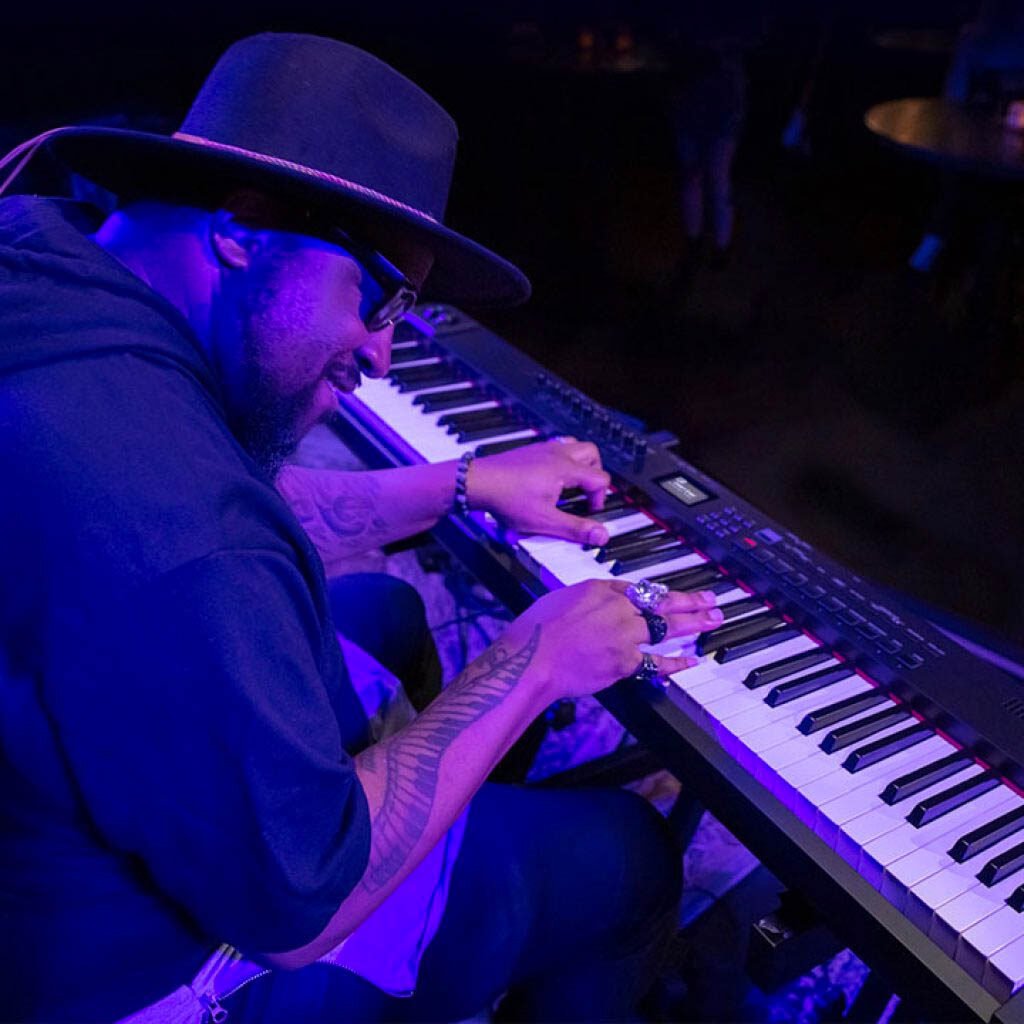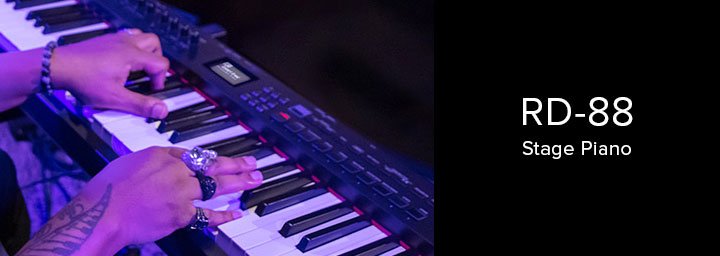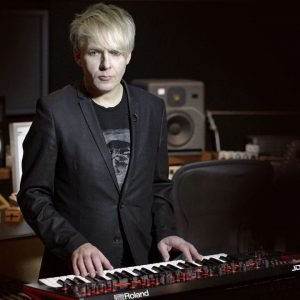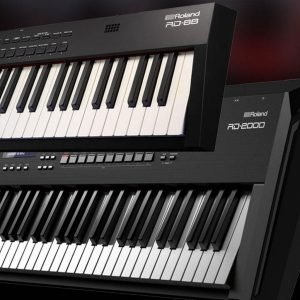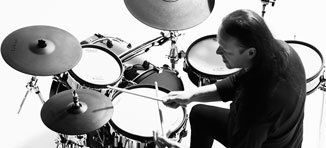RD pianos have been the choice of professional keyboardists for more than 30 years, appearing on stages around the world. Now, the acclaimed RD sound and playability comes to life in a lighter, more accessible, and more affordable instrument. Equipped with the 88-note PHA-4 keyboard, the RD-88 provides exceptional feel and response with Roland’s award-winning hammer action and Ivory Feel keys.
Every musical nuance is perfectly translated, giving serious players the inspiring touch they need for authentic performances. This quick access guide provides all the information needed to unlock the power of the RD-88.
Contributed by Keegan McCarthy for the Roland Australia Blog
Table of Contents
1. Rear Panel Connections
On the back of the RD-88 there are multiple connection options available including but not limited to – Mic and Line inputs, MIDI out, USB Memory and USB Computer port (Supports USB MIDI/AUDIO)
To find out more about the connections available on the RD-88 please watch this video.

2. Control Panel (Quick Guide)
The Control Panel is found on the top face of the keyboard , this is where interaction with all of the RD-88’s parameters and settings is made easy and accessible. In this video Maura Goya provides a guide of how to use the keyboards control surface.
This short video guide covers the following topics.

- Display and Dedicated Control buttons
- Pitch Bend and Modulation
- Tone Color and MFX Settings
- Volume and Mic/Line in Volume.
- Knob Functions / EQ
- Assign button
- Compressor
- Transpose Button
- Split Button (Split the Keyboard)
- Dual Button
- External Device Controls
- Mic/Line Settings
- Sound Categories buttons
- One Touch Piano button (Saved sound quick select)
- Scene selection
- Menu Button
- Write Button
- Key Touch Button
- Internal Rhythm and USB Audio Buttons
- Speaker Button
- Panel Lock Button
- Shortcut Buttons
3. Display & Shortcuts

4. Sound Library
The RD-88 has over 3000 sounds including the award-winning SuperNATURAL piano’s and SuperNATURAL Electric Piano’s. Roland’s famous ZEN-Core Synthesis System is also onboard with thousands of customizable sounds to be explored. There are multiple sound categories and within each category there is a list of sounds that can be used.
The integration of Software Synths and Audio sample control also allows the player to use their laptop to increase flexibility and creativity over three configurable zones of the keyboard.
A saved combination of sounds and effects is called a Scene. This could be a single sound with dedicated effects saved as a single Scene. Another saved Scene could be a combination of two sounds with dedicated effects in the Dual or Split mode. Three sounds can be used in the Layers mode. The Dual, Layers and Split modes will be covered in this article.
In this video Mauro explains how to access the Sound Libraries on the Roland RD-88. He also covers how to navigate the different sound categories and create Scenes.

5. Volume
In this video Mauro covers the Volume parameters of the RD-88. He begins with the Master Volume knob which controls the analog output volume.
He then covers how to access the volume controls for the individual parts volumes, these volume controls are used when Dual, Layers or Split mode is in use, allowing you to control the volumes of individual sounds within a Scene.
The Digital Out Volume is also clearly explained here.
To learn more about how to control Volume on the Roland RD-88 please watch this video.

6. Key Touch
The RD-88 allows adjustment to the Key touch settings on a Global level and also on a Scene level. Key touch can be explained simply as the amount of force that needs to be applied to the keys in order to reach fortissimo (Highest Velocity). When the Key touch settings are changed globally they will affect the Key touch across the entire keyboard.
Key touch can be altered on a Scene level which will only effect the scene it has been edited within. It is also possible to change the key touch of the lower and upper sections of the Keybed independently of one another. This means that two different Key touch settings could be applied to the same instrument or two instruments when using split mode.
To learn more about Key Touch settings on the Roland RD-88 please watch this video.

7. Dual Function and Layers
The Dual Function allows for the combination of two sounds that can be played at the same time. For example, a piano could be paired with a string section or a synth pad. This type of layering is especially effective for pop songs and/or ballads.
Dual mode is when two sounds are combined, The Layers function is when three sounds are combined. In order to add a third sound to an already established Dual Scene, the Zone edit function is used. The RD-88 can combine a total of three sound layers giving the player an incredible amount of expressive tonal possibilities.
In this short video Mauro explains how to use the Dual and Layers functions on the Roland RD-88.

8. Split Function
The Split Function allows the keyboard to be divided into two or three parts. A different sound can then be allocated to each section of the Keyboard.
On the RD-88, a split can be at any place on the keyboard, for example, the bottom octave in the left hand could be assigned to a bass sound, the middle of the keyboard could be assigned to a piano sound and the upper right hand could be assigned to a lead instrument like an electric guitar.
This short video explains how to set the Split function on the Roland RD-88.

9. Transpose
Using the Transpose button, the user can easily transpose the key of the whole Roland RD-88. By pressing and holding the Transpose button you can select the number of semitones/tones higher or lower that you wish to set the keyboard.
The Transposition of specific Scenes is also possible. This means transpose settings can be saved alongside all of the other saved settings inside of a Scene.
To find out exactly how to transpose the Roland RD-88 and individual Scenes you can watch this short video here.

10. Reverb and Chorus / Delay
There are two dedicated knobs on the control panel that allow for the global Reverb and Chorus/Delay level to be set.
To find out how to change the Global Reverb, Chorus and Delay on the Roland RD-88 you can view this short video.

11. Tone Color and MFX
Different effects can be assigned to individual keyboard parts, upper 1, upper 2 and lower. These parts are known as Zones. The Stereo width and EQ of each part can be altered and Master FX can be added and altered, this enables the user to set up the perfect balance across each of the Sections within a Split , Dual or Layered Scene.
This video explains how to edit the Tone Color, EQ and Master FX of the Roland RD-88.

12. Compressor
The Roland RD-88 has a Global Compressor that can be switched on by pressing the dedicated button on the Control Panel. To edit the settings of the Compressor, hold the SHIFT button and press the COMPRESSOR button to enter the editing screen. This will load the Compressor on the display where all the settings can be modified.
The best time to alter the compressor settings is when you need to adjust the sound of your Roland RD-88 to match a new audio set up.
This short video outlines how to use the Compressor on the Roland RD-88.

13. Menu Button
Pressing the MENU Button allows for all functions of the RD-88 to be accessed and edited. Navigation is made easy using the Arrow buttons and the ENTER button is used to confirm a selection.
In some cases there will be a little arrow in the top right corner of the display. This means that there are other pages with more settings that can be edited. Press the right Arrow Button to change page and the left button to go back a page.
To adjust the value of a parameter is easy, the INC (increase) and DEC (decrease) buttons can be used.
When editing has been completed remember to save using the WRITE button.
Watch this sort video to learn how to navigate the Roland RD-88 Menu.

14. Scene Edit
After pressing the menu button on the RD-88 control panel, select SCENE EDIT to enter the global settings for the Scene that is being edited. The individual parameters of the Scene that is being worked on can be changed in this menu. The Scene Volume, Tempo for internal scene rhythm and Voice Reserve are all accessible through this path.
ZONE EDIT can also be accessed by pressing MENU on the RD-88 control panel, navigating to the SCENE EDIT Menu and then selecting the ZONE EDIT option. Zones are the individual parts that make up a Split, Dual or Layer within a Scene. All the parameters needed to edit Zones can be found within this menu.
Navigate to the ZONE SOUND menu within the SCENE EDIT menu to edit the individual sound settings of any chosen Zone such as Mono/poly, Pitch, Scale Tune and EQ. To change the Zone your editing you can click the big square Zone buttons with the yellow lights. You can edit, Upper 1, Upper 2 and Lower.
To allocate effects to a Zone and then edit them you will need to navigate to ZONE EFFECTS within the SCENE EDIT menu. You can also add effects to the Entire Scene inside of the SCENE EDIT menu.
For a more in depth look at how to edit Scenes on the Roland RD-88 please watch this short video.

15. System Effects
On the RD-88 you can edit the SYSTEM EFFECTS which are the Global effects that will affect the entire Keyboard and all saved Scenes. Press the MENU button and select the SYSTEM EFFECTS option. To adjust the parameters of the effects, select the effect by clicking the right and left arrow buttons. To edit a specific parameter under the chosen effect use the up and down buttons to highlight it and click the ENTER button. The parameters of the Master EQ and Master Compressor can be edited this way and then saved using the WRITE button on the control panel.
To find out how to edit system settings on the Roland RD-88 please watch this video.

16. System
Setting different Global parameters on the Roland RD-88 allows for settings to be allocated to the entire keyboard. By clicking the MENU button and then selecting the SYSTEM option the user will see a list of parameters that can be edited.
By selecting the GENERAL option, the user can change parameters such as the Master Tune, the volume of rhythm patterns and songs as well as the LCD contrast.
By clicking the EXIT button, the user is then taken back to the SYSTEM SETTING page where they can edit the Global KEY TOUCH settings. Here the functions that are assigned to the knobs, buttons and wheels can be edited using the ASSIGN option. Next, the MIDI option allows for the editing of MIDI settings and the control of external devices.
USB Audio is the final option in SYSTEM SETTINGS menu. The user can edit the digital audio output volume and change the scale tune. Changing the scale tune is especially useful for those who want to play in oriental scales.
For an easy-to-follow walk through of the Roland RD-88 System settings please watch this video.

17. Input Settings
The Roland RD-88 allows for the connection of a microphone or an external audio device. Effects and a dedicated EQ can then be added to the input.
This allows the user to control a mic and line input from the RD-88 itself. This is useful for singers who wish to control their performance entirely from the Rd-88.
Watch this video to learn more.

18. Utility
The Roland RD-88 has an easy to use UTILITY menu with a few useful options to consider. BACKUP enables the user to back up their User settings onto a USB so that there is always a copy to come back to. The back up file includes all Scene settings, all Favourite Scenes and System settings. Using the RESTORE option in the utility menu the user is able to load a previous instance of RD-88 settings from the USB Flash-Drive back up.
IMPORT TONE is the next option in the menu. This option enables the user to load new sounds on to the RD-88, new sounds can be downloaded from Roland Cloud and copied onto the users USB flash drive to then be loaded into the RD-88.
FACTORY RESET is the next option in the Utility menu, it is important to perform a Back Up before performing a FACTORY RESET so no previous saved data is lost.
USB FORMAT is the next option in the utility menu, and it is where the users external USB Flash-Drive can be formatted for use with the RD-88.
To learn more about the the Roland RD-88 Utility options please watch this video.

19. Information
By pressing the MENU button and then selecting the INFORMATION option the Software Version will be displayed. We recommend that the user check this periodically to ensure that the RD-88 is running the latest Operating Software.
To learn how to view the Roland RD-88 Software Version watch this video.

20. Write Scene & System
Scenes are a selection of sounds and effects that are fully programmable and can be saved to then recall later. The System settings are Global Parameters that are applied in general to the RD-88.
There are 400 scenes that can be used. The big number in the top left-hand corner of the LCD display indicates the scene you have selected. After editing the sounds and effects the user can then save the scene using the WRITE button.
To learn how to save and edit Scene Settings and System Settings on the Roland RD-88 please watch this video.

21. Pedal Controls
The pedal functions of the Roland RD-88 can be edited by clicking the MENU button, SCENE EDIT and then selecting the ASSIGN option. Click the left arrow button until the PEDAL screen is reached. A shortcut to reach the Pedal editing screen is to hold the Shift button and press the ASSIGN button.
To learn more about how to edit the Pedal Parameters of the RD-88 please watch this video.

22. Wheel Controls
The Roland RD-88 has two useful control wheels. To easily set the function of each wheel, the user can hold the SHIFT button and move one of the wheels. This will load the ASSIGN screen. The parameters allocated to the wheels can be edited here.
To learn more about how to edit the Wheel Parameters of the RD-88 please watch this video.

23. Knob Controls
The parameters assigned to the eight knobs on the top right-hand side of the RD-88 Control panel can be edited to suit the user’s needs. By holding the SHIFT button and clicking the ASSIGN button the Knob parameter screen will load on the display.
Please refer to this PDF Parameter Guide to view a list of all assignable functions.
To find out how to assign function to the knobs of the Roland RD-88 please view this video.

24. Favorite Scene
Every Scene is a combination of Sounds and Effects, the scene that is selected will be displayed by a number in the top left-hand corner of the display. There are already several Scenes on the RD-88. The user can create up to 400 Scenes.
There are also 10 different banks that enable the user to save Favorite scenes. The Scene can then be loaded by pressing one of the large square buttons on the right-hand side of the display. This makes calling up a saved instance of the user defined Keyboard settings quick and easy. The user can then quickly select the Scene they need depending on musical style and the requirements of their setting.
To learn how to set up Favorite Scenes on the Roland RD-88 please watch this Video.

25. One Touch Piano Button
The One Touch Piano button allows for the recall of the user’s number one favorite scene. This enables the player to have a grounding point to come back to quickly at any time during a performance, lesson, composition or studio session.
It is called One Touch Piano, but any sound combination can be assigned to this quick recall button. Once the Favorite Scene has been chosen, press and hold the WRITE button and then press the One Touch Piano button. This will save the chosen Scene to the One Touch Piano Button.
To learn more about the One Touch Piano feature on the Roland RD-88 please watch this video.

26. Internal Rhythms
The Roland RD-88 comes pre-loaded with an Internal Rhythms bank which consists of hundreds of drum tracks that can be used to accompany the player for practice or performance.
By pressing the SELECT button the RHYTHM screen will load on the display. Here the player can choose the Rhythm, Tempo and Volume of the accompaniment.
To learn more about the Internal Rhythms feature of the Roland RD-88 please watch this Video.

27. USB Audio Files
The Roland RD-88 is able to play Audio Files copied to a USB Flash-drive. The USB Flash-drive must first be formatted using the UTILITY menu as previously outlined in this article under number – 18. Utility. The Roland RD-88 will create two files on the USB, one that is called Roland (Backup files) and the other which is titled Song List. Song List is where the users Audio Files can be copied, MP3 and WAV files are both supported on the RD-88.
This feature is useful in a live setting or practice setting as the RD-88 player can have an entire playlist of backing tracks to accompany themselves and those they are playing with.
To find out more about using USB Audio Files on the Roland RD-88 please watch this video.

28. Panic Function
Sometimes, playing layers of rich sounds or while using a Midi connection, a note can remain stuck and not receive the key off command. This means that a note can sometimes sustain after the chord being played has ended. In this case press the SHIFT button and then the PANIC button. A Global Key Off command will be triggered making the stuck note end.
To learn more about the PANIC button on the Roland RD-88 please watch this video.

29. Panel Lock
To avoid accidentally touching any buttons whilst playing the RD-88 the PANEL LOCK button on the top right-hand corner of the control panel can be turned on effectively disabling all the buttons on the Control Panel. A lock symbol will be displayed in the top right corner of the display when Panel Lock is activated.
To learn how to turn off all buttons when playing the Roland RD-88 please watch this video.


